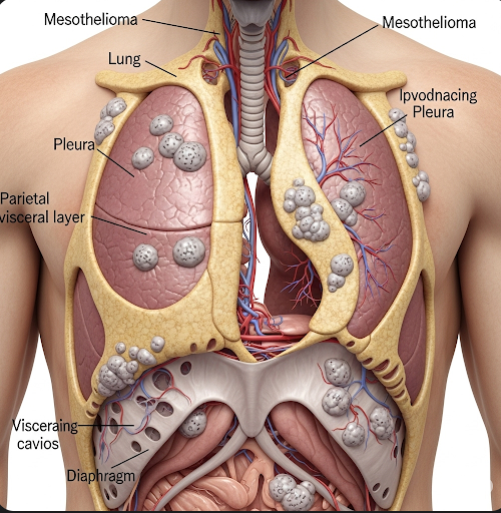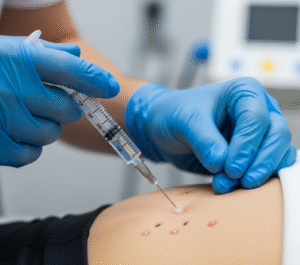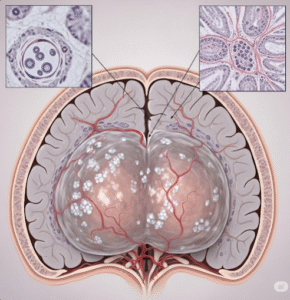Overview
Pleural mesothelioma is a rare but aggressive form of cancer that affects the pleura — the thin layer of tissue that lines the lungs and chest wall. It is caused almost exclusively by exposure to asbestos, often decades before symptoms appear. This disease is challenging to diagnose early due to its slow development and nonspecific symptoms. While there is no known cure, early detection and a combination of therapies can help extend life expectancy and improve quality of life.
What is Pleural Mesothelioma?
Pleural mesothelioma occurs when cancer cells form in the pleural lining of the lungs. It is the most common type of mesothelioma, accounting for about 75% of all cases. The disease progresses as tumor cells thicken the pleura and may spread to nearby structures, making breathing difficult and painful.
There are three primary histological subtypes:
- Epithelioid – most common and has the best prognosis
- Sarcomatoid – rarer and more aggressive
- Biphasic – a mixture of epithelioid and sarcomatoid cells
Symptoms
Symptoms often don’t appear until the disease is advanced. Common signs include:
- Persistent chest pain or discomfort
- Shortness of breath, especially during physical activity
- Chronic cough or hoarseness
- Unexplained weight loss and fatigue
- Pleural effusion (fluid buildup between the lung and chest wall)
- Swelling of the face or arms
- Difficulty swallowing
- Night sweats or fever in some cases
Because the symptoms resemble other respiratory illnesses, pleural mesothelioma is often misdiagnosed in early stages.
Causes
The primary cause of pleural mesothelioma is inhalation of asbestos fibers. These tiny, sharp particles become lodged in the pleura, causing chronic irritation and inflammation that can eventually lead to DNA damage and cancer formation.
Key causes include:
- Occupational asbestos exposure (construction, shipbuilding, insulation work)
- Secondary exposure (family members of exposed workers)
- Environmental exposure in areas near asbestos mines or industries
- Use of asbestos-containing products (roofing, tiles, brake pads, etc.)
Risk Factors
Several factors increase the risk of developing pleural mesothelioma:
- Asbestos exposure – the most significant and direct risk
- Occupational history – jobs in construction, factories, naval shipyards
- Duration of exposure – risk increases with the amount and length of exposure
- Age – usually diagnosed in people aged 60–80
- Gender – more common in men due to occupational exposure
- Radiation exposure to the chest area
- SV40 virus exposure (Simian virus 40, controversial and still under investigation)
- Genetic predisposition – rare, but possible
Complications
As pleural mesothelioma progresses, it may lead to serious complications:
- Severe breathing difficulties due to lung compression
- Intractable chest or back pain
- Spread to nearby organs, such as the pericardium (heart lining) or diaphragm
- Pleural effusion recurrence
- Weight loss and cachexia (wasting syndrome)
- Reduced lung function and mobility
- Emotional distress and reduced quality of life
- Shortened life expectancy, typically 6–24 months without treatment
Prevention
Since asbestos exposure is the main cause, prevention focuses on limiting exposure:
- Avoid asbestos-containing materials, especially in older buildings
- Use protective equipment if working in high-risk environments
- Follow occupational safety regulations strictly
- Professional asbestos removal if found in homes or buildings
- Public awareness campaigns in regions with high historical asbestos use
- Regular health screenings for individuals with a known exposure history
Early diagnosis in high-risk individuals is key to improving outcomes.
Treatment Options in Korea
South Korea is equipped with state-of-the-art oncology centers offering multimodal treatments for pleural mesothelioma. Treatment plans depend on the stage, cell type, patient health, and extent of spread.
1. Surgery
- Extrapleural pneumonectomy (EPP): Removal of lung, pleura, diaphragm, and pericardium
- Pleurectomy/decortication (P/D): Removal of pleura and visible tumor while preserving the lung
- Video-assisted thoracoscopic surgery (VATS): Minimally invasive for early-stage or palliative procedures
2. Chemotherapy
- First-line drugs: Pemetrexed + Cisplatin or Carboplatin
- Used before (neoadjuvant) or after (adjuvant) surgery, or as primary treatment in non-surgical cases
3. Radiation Therapy
- External beam radiation to shrink tumors and relieve pain
- Often used as part of trimodal therapy (surgery + chemo + radiation)
4. Immunotherapy
- Newer treatments such as nivolumab (Opdivo) and ipilimumab (Yervoy) show promise
- Available in clinical trials and select oncology centers
5. Palliative Treatments
- Thoracentesis or pleurodesis to manage pleural effusion
- Pain management and oxygen therapy
- Nutritional and psychological support
6. Diagnostic and Support Services in Korea
- High-resolution CT scans, PET scans, and MRI for staging
- Thoracoscopy and biopsy for tissue diagnosis
- Genetic and molecular testing for targeted therapy decisions
- Multidisciplinary teams of thoracic surgeons, oncologists, pulmonologists, and palliative care experts
- English-speaking services at major hospitals such as Samsung Medical Center, Seoul National University Hospital, and Asan Medical Center
- International patient programs with full medical concierge services













